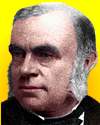
On 5 May 1811, John William Draper was born, the English-American chemist who pioneered in photochemistry.
His interest in spectroscopy and photography was applied to give the first astronomical photograph. Its subject was the moon (1840). He also studied photographs of the solar spectrum to show that contained both infrared and ultraviolet light. His photographs of persons include the oldest surviving photographic portrait (1840), and he was one of the first to produce microphotographs.
His interests extended to publishing such books as a History of the American Civil War and History of the Intellectual Development of Europe.
He died on 4 Jan 1882. A few years earlier, in 1878, he published his Scientific Memoirs, Being Experimental Contributions to a Knowledge of Radiant Energy. The Preface provides a summary in his own words of his work on the effects of radiations and on radiant energy. He includes autobiographical remarks explaining how his interests encompassed physiological subjects, and from there he considered social relations of man.
The Preface concludes with his remarks on how, looking back, he recognized that all the objects of his attention had been interconnected.
By reading the Preface, you will find Draper was a fascinating and industrious person, extending beyond his explorations in physical science.

On 5 May 1921, Arthur L. Schawlow was born, who was awarded a Nobel Prize in physics for his work in developing the laser and in laser spectroscopy.On 5 May 2007, Theodore Maiman died, the American physicist who built the first working laser. Today's book pick is: The Laser Odyssey, by Theodore Maiman, who takes the reader through a riveting expose of the Machiavellian scene behind the creation of the first laser. It is a personable chronicle of a maverick scientist who defied conventional wisdom while he blazed his own trail.
During his career Maiman became acutely conscious of the dismissive attitude sometimes exhibited by academic scientists toward industrial scientists. He was in a special position to observe such prejudice because he made a major scientific advance while employed by an aerospace company. The book is written for the general reader, and so will be enjoyed by the lover of science or a physicist.
It is available from Amazon, typically about New from $50.00. Used from $16.00. (As of earlier time of writing - subject to change.)
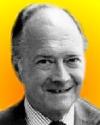 | Furious activity is no substitute for analytical thought. |
 | Every movement in the skies or upon the earth proclaims to us that the universe is under government. |
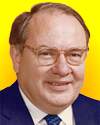 | One never knows what remains undiscovered simply because the right equipment is not there at the right time. |
| Before you look at today's web page, see if you can answer some of these questions about the events that happened on this day. Some of the names are very familiar. Others will likely stump you. Tickle your curiosity with these questions, then check your answers on today's web page. | |
| Births | |
 | On 5 May 1921, Arthur L. Schawlow was born, who developed the laser and its use in laser spectroscopy. For this work, he was awarded a Nobel Prize. In which decade was Arthur Schawlow a Nobel Prize? |
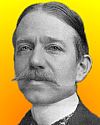 | Peter Cooper Hewitt, born 5 May 1861, was an American electrical engineer who invented a new advance in electrical lighting. What form of lighting did he invent? |
| Deaths | |
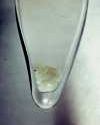 | Dr Joseph William Kennedy (1916-57) was one of four American scientist that co-discovered a new element by bombarding uranium oxide with deuterons in a cyclotron at the University of California at Berkeley. By 28 Mar 1941, with Emilio Segrè, he demonstrated that this element was fissionable with slow neutrons, like uranium-235, and thus another element that could be suitable as a fission bomb material. Can you name the new element? |
| Events | |
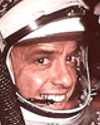 | America's first astronaut was launched on a 15 minute sub-orbital flight that reached an altitude of 115 miles, during which he experienced about five minutes of "weightlessness." He rode in the Freedom 7 launched from Cape Canaveral, Florida, by a Mercury-Redstone 3 rocket. But, he had been beaten into space by the Russian cosmnonaut Yury Gagarin, the world's first human who reached orbit less than one month earlier. What is the name of America's first astronaunt in sub-orbital flight? |
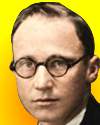 | In 1925, George W. Rappelyea and other local leaders in Dayton, Tennessee, held a meeting to plan a challenge to that state’s new law, the Butler Act, which forbade teaching Darwin’s theory of evolution. The American Civil Liberties Union had offered to give legal support. Rappelyea saw the publicity that would accompany such a trial as an opportunity to promote his town. Rappelyea found John T. Scopes, a teacher willing to become the defendant in a test of the legality of the law in court. What was the verdict at the trial, which began just over two months after the first meeting to initiate the trial? |
Fast answers for the previous newsletter for May 4: rocket-powered transport • Samuel Wilberforce • Augustus Henry Lane-Fox Pitt-Rivers • to maximize the speed and efficiency of navy ships by laboratory work examining scale models in a towing tank • Sears Tower, Chicago, Illinois • phonograph disk record • American Academy of Arts and Sciences.
 If you enjoy this newsletter, the website, or wish to offer encouragement or ideas, please send feedback by using your mail reader Reply button.
If you enjoy this newsletter, the website, or wish to offer encouragement or ideas, please send feedback by using your mail reader Reply button. Your click on a Facebook, StumbleUpon, or other social button on the site webpages is also a welcome sign of appreciation. Thank you for using them.
© This newsletter is copyright 2020 by todayinsci.com. Please respect the Webmaster's wishes and do not put copies online of the Newsletter — or any Today in Science History webpage. (If you already have done so, please remove them. Thank you.) Offline use in education is encouraged such as a printout on a bulletin board, or projected for classroom viewing. Online, descriptive links to our pages are welcomed, as these will provide a reader with the most recent revisions, additions and/or corrections of a webpage. For any other copyright questions, please contact the Webmaster by using your mail reader Reply button.
--
If you do not want to receive any more newsletters, Unsubscribe
To update your preferences and to unsubscribe visit this link
Executive Real Estate Business Class
-
"It was like a man with wings. It wasn't like anything you'd see on TV or in a monster movie." ...
About the publisher
Search This Blog
Blog Archive
-
▼
2020
(1542)
-
▼
May
(194)
- FAMILY: Building kindness in a tough time
- What is history's biggest mystery?
- On This Day for May 31 - Adolf Eichmann hanged, Cl...
- Globalist Race War? because COVID Coup exposed? ...
- Newsletter for Sunday 31 May.
- May 31: Battle of Jutland, Earthquakes and the Clo...
- BREAKING NEWS: SpaceX launches new era of spacefli...
- The Compass: Spain
- On This Day for May 30 - Joan of Arc burned at the...
- Newsletter for Saturday 30 May.
- CORONAVIRUS SPECIAL EDITION: The best way to clean...
- May 30: Voltaire the Rebel
- This Week's Roundup Top Ten from History News Network
- On This Day for May 29 - Mount Everest summit reac...
- Newsletter for Friday 29 May.
- You & your loved ones can be Involuntarily Quarant...
- YOUR WEEKLY ESCAPE: The famous Viking warrior who ...
- May 29: Return of Charles II, Mt. Everest Knocked ...
- Alone Returns With a $1,000,000 Prize
- On This Day for May 28 - Amnesty International fou...
- The secular utilitarian U.N. New World Order has a...
- Newsletter for Thursday 28 May.
- May 28: Spanish Armada Sets Sail, The Indian Remov...
- SCIENCE: Restoring an American frontier
- Breaking News from History News Network
- On This Day for May 27 - Founding of St. Petersbur...
- Christian History Magazine: Covid-19 Response
- Newsletter for Wednesday 27 May.
- Learn whose pulling the strings what the media ha...
- May 27: Habeaus Corpus, Priam's Treasure and Dunkirk
- TRAVEL: Find the secrets to your backyard
- Journey with Ancient Explorers when you subscribe ...
- On This Day for May 26 - Martin Luther declared a ...
- Newsletter for Tuesday 26 May.
- May 26: Start of the Dow Jones Index, Middle Easte...
- HISTORY: The tumultuous past of the U.S. Postal Se...
- A Memorial Day Offer from Britannica!
- Grant Premieres Tonight!
- New This Week On History News Network
- On This Day for May 25 - U.S. Constitutional Conve...
- Economic Re-Opening is a Fakeout + CDC numbers rev...
- Newsletter for Monday 25 May.
- May 25: On This Day in History
- FAMILY: Moving past a big disappointment
- The real history behind WW2 film 'Greyhound' | Ann...
- On This Day for May 24 - Opening of the Brooklyn B...
- Newsletter for Sunday 24 May.
- Vaccine: 20 percent Serious Injury after skipping ...
- May 24: Methodism, Morse Code and the Bridge that ...
- The Compass: Argentina
- Your New Favorite Podcast
- On This Day for May 23 - Tibet annexed by China, C...
- Watch all the talks from BBC History Magazine's Me...
- Newsletter for Saturday 23 May.
- Dolores Cahill PhD expert in molecular genetics an...
- CORONAVIRUS SPECIAL EDITION: There's a reason so m...
- May 23: The Crazy Trigger for the Thirty Years War
- PHOTOGRAPHY: Capturing 59 years of human spaceflight
- How Booze, Drugs, And A Woman Named June Destroyed...
- A Memorial Day Sale for Everyone!
- The Roundup Top Ten from History News Network
- On This Day for May 22 - Roman Emperor Constantine...
- Newsletter for Friday 22 May.
- YOUR WEEKLY ESCAPE: What do the world's happiest p...
- May 22: The World's 1st Atlas is Published and WWI...
- ANIMALS: Saving the pangolin
- On This Day for May 21 - First nonstop solo transa...
- May 21: The 1st Transatlantic Flights and some Mem...
- Ron Panzer interview will air on Friday on Trunew...
- Grant: Watch the Extended Opening Scene
- SCIENCE: Food supply challenges prompt creativity
- Breaking News from History News Network
- On This Day for May 20 - U.S. Homestead Act signed...
- Newsletter for Wednesday 20 May.
- Ron Panzer interview: Trunews.com Today at 3 pm E...
- May 20: Vasco da Gama, Shakespeare and My Fair Lady
- TRAVEL: The promise of happiness, even now
- Inspire Their Curiosity w/ Nat Geo Kids Magazine
- On This Day for May 19 - Ringling Bros. Circus for...
- When we learn what the vaccine will do to everyone...
- Newsletter for Tuesday 19 May.
- May 19: On This Day in History
- See The Most Accurate Map In The World
- HISTORY: At 110 years old, he made our cover
- New This Week on History News Network
- On This Day for May 18 - Eruption of Mount St. Hel...
- Newsletter for Monday 18 May.
- May 18: On This Day in History
- FAMILY: Helping your kids after their troubling dr...
- What did Queen Victoria really look like? | Mediev...
- On This Day for May 17 - School segregation outlaw...
- Newsletter for Sunday 17 May.
- Cardiologist states Hydroxychloroquine side-effect...
- May 17: NYSE Forms and the Watergate Hearings Begin
- The Compass: California
- On This Day for May 16 - Warsaw Ghetto Uprising su...
- Newsletter for Saturday 16 May.
- May 16: Dambusters and Stem Cells
- CORONAVIRUS SPECIAL EDITION: This map shows where ...
- The dream to photograph 10,000 vulnerable animal s...
-
▼
May
(194)
-
Blogroll
-
About
HistoryFact










0 comments:
Post a Comment